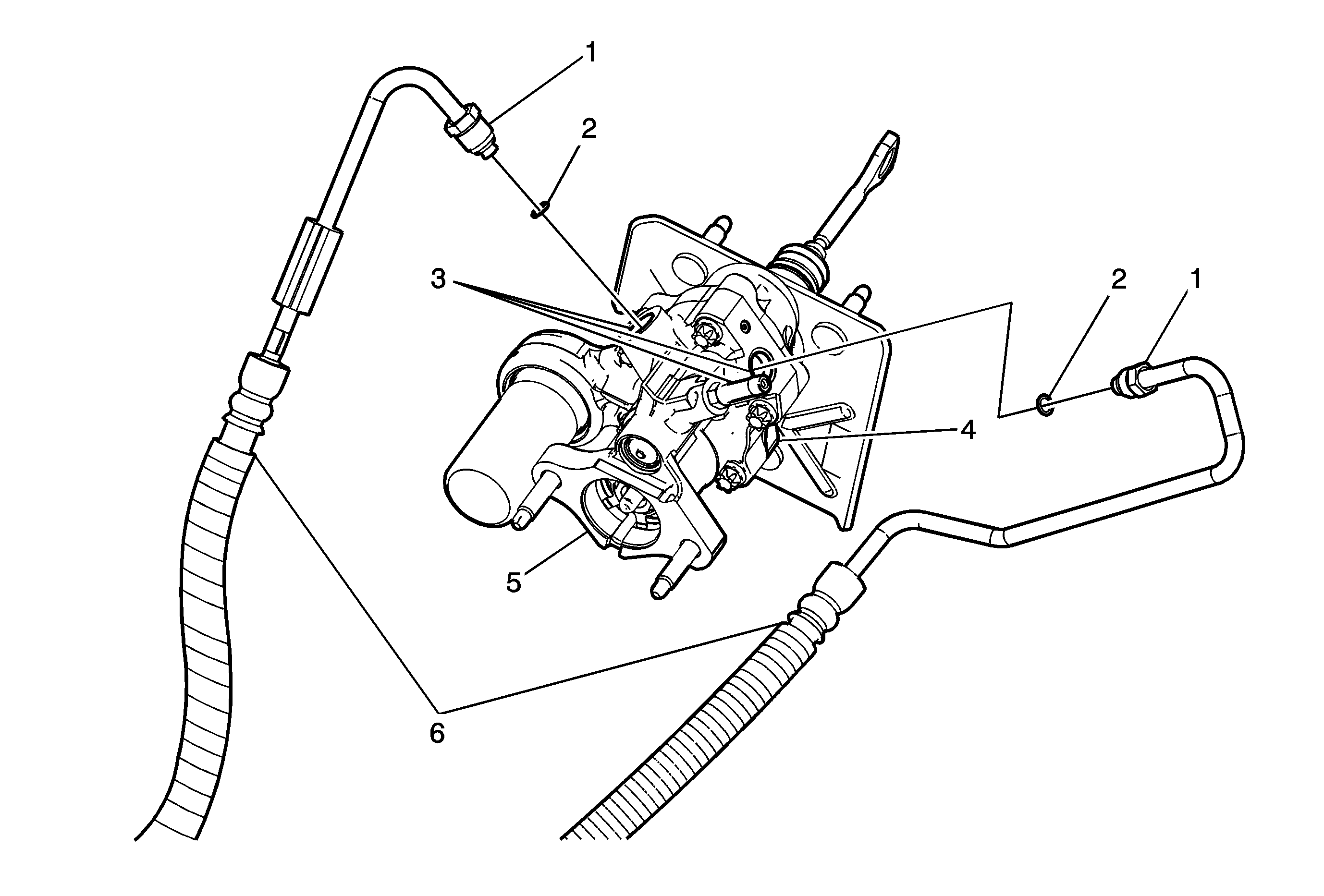Important: The power brake booster may appear wet due to excessive assembly fluid used during manufacture or brake fluid which may have been spilled during hydraulic brake system fill. To prevent unnecessary replacement of the power
brake booster, perform the following power brake booster leak inspection before replacing the power brake booster.
- Check the power steering system fluid level and adjust as necessary. Refer to
Checking and Adding Power Steering Fluid.
- Clean any fluid from the following areas:
| • | The power steering hose fittings (1) |
| • | The power steering hose ports (3) |
| • | The joint between the power brake booster housing and end cap (4) |
| • | The joint between the power brake booster housing and the master cylinder (5) |
| • | The power steering inlet and outlet hoses at the crimp joints (6) |
Important: To properly diagnose a leak condition, an assistant may be required. The power brake booster system must be observed while performing this inspection.
- Start the engine and allow the power steering fluid to reach operating temperature.
- Allow the engine to idle and slowly apply the brake pedal to run-out, holding until the power steering pump reaches the pressure relief valve setting and hisses.
Maintain the brake pedal force approximately two seconds, then release the
brake pedal.
- With the brakes fully released, allow the engine to idle for fifteen seconds.
- Repeat steps 4 and 5 four times.
Important: Do not hold the steering wheel at full stop for more than three seconds. Holding the steering wheel at full stop for more than three seconds will increase the power steering fluid in the power steering pump to above normal
operating temperature.
- With the engine idling, turn the steering wheel from stop to stop four times holding the steering wheel at each stop for two seconds.
- Increase the engine speed to approximately 1,000 RPM and turn the steering wheel approximately every one second. Do not hold the steering wheel at full stop.
- Allow the engine to idle without pressure applied to the brake pedal for thirty seconds.
- With the engine idling, apply the brake pedal to run-out and hold the pedal force at run-out for approximately one second and then release the brake pedal.
- Repeat steps 7 through 10 four times.
- Allow the engine to idle for thirty seconds and then turn the engine OFF.
Important: On low mileage vehicles, light moisture at the joint between the power brake booster housing and the end cap is acceptable. If fluid droplets develop during the hydraulic brake booster leak inspection diagnosis, the power
brake booster must be replaced.
- Inspect the power brake booster, the power steering hose fitting ports (3), and the power steering inlet and outlet hoses at the crimp joints (6) for any leaks.
- If there are leaks at the power steering inlet and/or outlet hoses at the crimp joints, the affected power steering hose requires replacement.
- If there are leaks at the power steering hose fittings (1) to the hydraulic booster ports (3), perform the following steps:
| • | Tighten the leaking power steering hose assembly fittings to the proper specifications |
| • | Inspect again for fluid leaks at the affected locations |
- If there are leaks at the power steering hose fittings after tightening the fittings, perform the following steps:
| • | At each affected location, disconnect the power steering hose fitting |
| • | Inspect the sealing end of the power steering hose fitting for damage and replace the hose if damaged |
| • | Install a new O-ring seal (2) to the power steering hose |
| • | Install the power steering hose and tighten the fitting to the proper specification |
| • | Inspect again for fluid leaks at the affected location |
Important: A leak between the power brake booster and the master cylinder is not acceptable. If a leak is present, the type of fluid must be determined. Power steering fluid indicates the power brake booster requires replacement.
Brake fluid indicates an issue with the brake master cylinder.
- If the power brake booster is leaking, replace the power brake booster. Refer to
Power Brake Booster Replacement.
- If brake fluid is leaking, refer to
Brake Fluid Loss.

